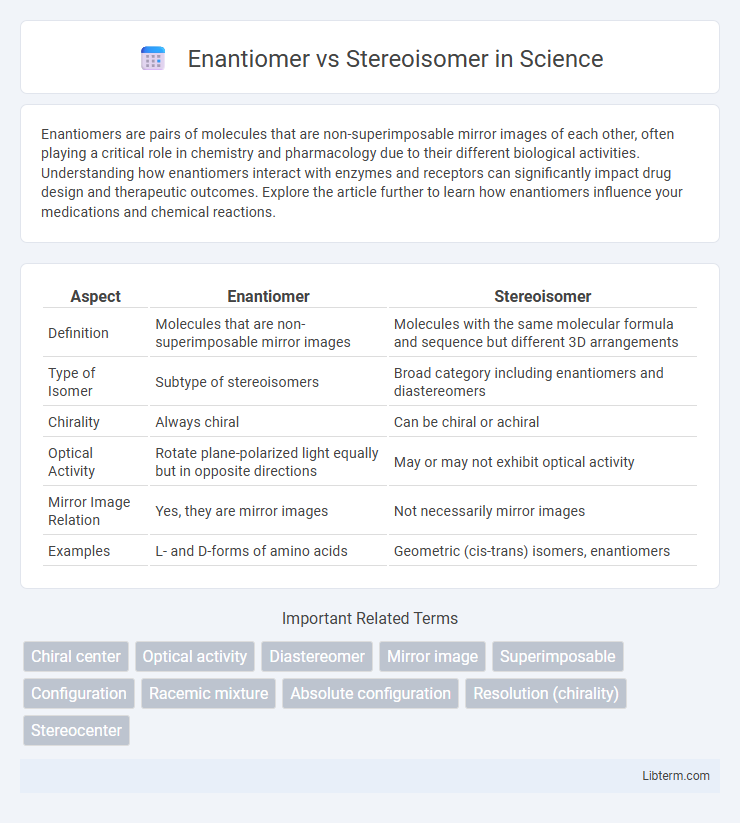Enantiomers are pairs of molecules that are non-superimposable mirror images of each other, often playing a critical role in chemistry and pharmacology due to their different biological activities. Understanding how enantiomers interact with enzymes and receptors can significantly impact drug design and therapeutic outcomes. Explore the article further to learn how enantiomers influence your medications and chemical reactions.
Table of Comparison
| Aspect | Enantiomer | Stereoisomer |
|---|---|---|
| Definition | Molecules that are non-superimposable mirror images | Molecules with the same molecular formula and sequence but different 3D arrangements |
| Type of Isomer | Subtype of stereoisomers | Broad category including enantiomers and diastereomers |
| Chirality | Always chiral | Can be chiral or achiral |
| Optical Activity | Rotate plane-polarized light equally but in opposite directions | May or may not exhibit optical activity |
| Mirror Image Relation | Yes, they are mirror images | Not necessarily mirror images |
| Examples | L- and D-forms of amino acids | Geometric (cis-trans) isomers, enantiomers |
Introduction to Molecular Isomerism
Molecular isomerism encompasses compounds with identical molecular formulas but different arrangements of atoms, resulting in distinct properties. Enantiomers are a specific type of stereoisomer characterized by non-superimposable mirror images, crucial in fields like pharmaceuticals for their unique biological activities. Understanding the differentiation between enantiomers and other stereoisomers forms the foundation for advanced studies in stereochemistry and molecular interactions.
What Are Stereoisomers?
Stereoisomers are compounds that have the same molecular formula and sequence of bonded atoms but differ in the three-dimensional orientations of their atoms in space. These include enantiomers, which are non-superimposable mirror images of each other, and diastereomers, which are not mirror images. Understanding stereoisomers is crucial in fields like pharmaceuticals, where different spatial arrangements can result in vastly different biological activities.
Classification of Stereoisomers
Stereoisomers are classified into enantiomers and diastereomers based on their spatial arrangement around chiral centers. Enantiomers are non-superimposable mirror images with opposite configurations at all stereocenters, whereas diastereomers differ at one or more but not all stereocenters and are not mirror images. This classification is crucial for understanding the chemical and biological properties of stereoisomeric compounds.
Understanding Enantiomers
Enantiomers are a specific type of stereoisomer characterized by non-superimposable mirror images, often involving chiral molecules with asymmetric carbon atoms. Understanding enantiomers is crucial in fields like pharmacology because they can exhibit drastically different biological activities despite having identical molecular formulas and connectivity. Their optical activity, where they rotate plane-polarized light in opposite directions, is a key factor distinguishing enantiomers from other stereoisomers such as diastereomers.
Key Differences: Enantiomers vs Other Stereoisomers
Enantiomers are a specific type of stereoisomer that are non-superimposable mirror images of each other, characterized by opposite configurations at every chiral center. Other stereoisomers include diastereomers, which are not mirror images and differ at one or more but not all chiral centers, resulting in distinct physical and chemical properties. Enantiomers share identical physical properties except for the direction in which they rotate plane-polarized light and their interactions with chiral environments, while diastereomers exhibit different melting points, boiling points, and reactivities.
Chirality and Optical Activity
Enantiomers are a specific type of stereoisomer characterized by non-superimposable mirror images due to the presence of chirality centers, usually asymmetric carbon atoms. Chirality in enantiomers leads to optical activity, meaning these molecules rotate plane-polarized light in opposite directions with equal magnitude but opposite sign, a property quantified by specific rotation. In contrast, stereoisomers include both enantiomers and diastereomers, where not all stereoisomers exhibit chirality or optical activity, making enantiomers unique in their consistent influence on polarized light.
Importance in Pharmaceuticals
Enantiomers, a specific type of stereoisomer, are crucial in pharmaceuticals due to their mirror-image molecular structures that can exhibit drastically different biological activities and therapeutic effects. Understanding the distinction between enantiomers and other stereoisomers enables precise drug design, optimizing efficacy and reducing adverse side effects by targeting specific receptors or metabolic pathways. Regulatory agencies like the FDA often require enantiomeric purity assessments to ensure drug safety and consistency in pharmaceutical development.
Methods for Identifying Enantiomers
Methods for identifying enantiomers primarily involve chiral chromatography, optical rotation measurement via polarimetry, and circular dichroism spectroscopy. Chiral chromatography separates enantiomers based on their interaction with a chiral stationary phase, enabling precise quantification and purity analysis. Optical rotation provides a direct assessment of the enantiomeric form by measuring the direction and magnitude of plane-polarized light rotation, while circular dichroism offers insight into chiral molecular conformations through differential absorption of left and right circularly polarized light.
Biological Significance of Stereochemistry
Stereochemistry profoundly influences biological activity, as enantiomers often exhibit drastically different interactions with chiral biomolecules like enzymes and receptors. While enantiomers are non-superimposable mirror images crucial for drug efficacy and safety, stereoisomers encompass a broader category including diastereomers with distinct spatial arrangements affecting pharmacodynamics. Understanding the stereochemical configuration enables precise targeting in drug design, metabolic pathways, and molecular recognition essential for effective pharmaceutical development and therapeutic outcomes.
Conclusion: Choosing the Right Isomer
Selecting the appropriate isomer depends on the specific chemical and biological context, where enantiomers are crucial for applications requiring chiral purity, such as pharmaceuticals. Stereoisomers encompass a broader category including enantiomers and diastereomers, each influencing molecular properties differently. Understanding the distinct effects of enantiomers versus other stereoisomers optimizes effectiveness and safety in compound design.
Enantiomer Infographic

 libterm.com
libterm.com